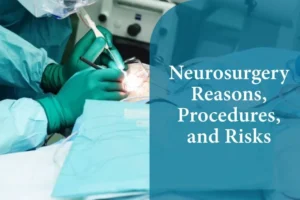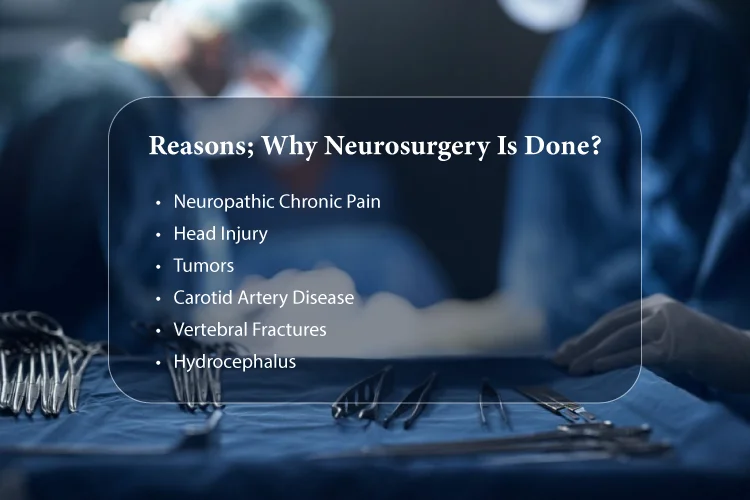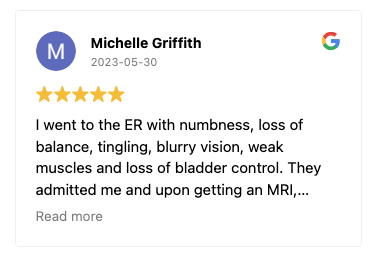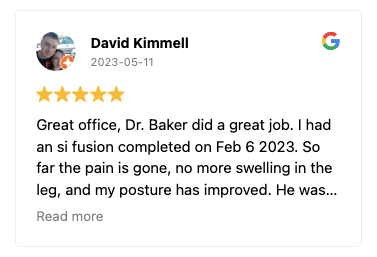Neurosurgery—Reasons, Procedures, and Risks

A Complete Guide on Neurosurgery
According to research, almost 60% of the US population lives with one or more neurological disorders. Such an alarming number makes neurosurgery the need of the hour to relieve patients’ pain. Neurosurgery is the surgical procedure performed on the nervous system, including the brain and spinal cord.
Neurosurgery treats the diseases and disorders of the brain, spinal cord, spinal column, and peripheral nervous system. In addition to learning about why a patient needs neurosurgery and the risks of neurosurgery in this blog, you will also learn about its main procedures.
Reasons; Why Neurosurgery Is Done?
Although there could be various reasons why you need neurosurgery, the most common ones are here:
Neuropathic Chronic Pain:
Any nerve damage or injury (between the brain and spinal cord) leads to chronic neuropathic pain. This pain has a burning sensation, and the affected areas become sensitive to touch. To reduce neuropathic pain, your neurosurgeon performs surgery on areas having pain.

Head Injury:
Accidents and falls cause head injuries which are possibly life-threatening also. So, head injuries are treated by neurological surgeries that help to reduce the damage to the brain.
Tumors:
For spinal, pituitary, and brain tumors, in the majority of cases, neurosurgery is the only option to save precious lives. Tumors spread very fast, so timely removal through surgical treatments is necessary.
Carotid Artery Disease:
In this disease, the fats clog the blood vessels which are responsible for supplying blood to the brain. Hence, it causes severe damage to the central nervous system. So, a neurosurgeon may perform certain neurological treatments to eliminate this disease from the patient’s body.
Vertebral Fractures:
When the vertebral body in the spinal cord collapses, vertebral compression fractures occur. These fractures cause severe pain, loss of height, and deformity to the patient. You may require neurosurgery for these fractures.
Hydrocephalus:
When a brain fills with fluid, the condition is known as hydrocephalus. It causes pressure and pain in the brain; thus, neurosurgeons recommend urgent treatment through surgical procedures.
Besides the conditions mentioned above, herniated discs, sciatica, trigeminal neuralgia, strokes, and cervical spine disorders are also why a person needs neurosurgery.
Neurosurgical Procedures
A neurosurgeon chooses a specific neurological surgery depending on the particular neurological disorder and the patient’s condition. There are different neurological surgeries, but the most common ones are here.
Craniotomy
Many neurological concerns, mainly head strokes and brain tumors, are treated through craniotomy. In this surgery, a surgeon removes a part of the skull to access the targeted area. It’s a surgical opening into the skull called open surgery. These days, surgeons prefer minimally invasive techniques to perform this procedure.
Ventricular Shunting
A ventricular shunt is a narrow plastic tube inserted in the brain to drain excess cerebrospinal fluid (CSF). When too much CSF is present in the brain, it causes pressure and pain. Thus, it’s better to go for ventricular shunting to relieve this pain. It is indeed one of the most common types of neurosurgery.
Chiari Decompression
Chiari malformation is a condition in which the brain tissues of the patient extend to the spinal canal and causes an imbalance. Thus, Chiari decompression surgery creates more brain space and widens the foramen magnum. It results in an improvement in coordination and balance.
Epilepsy Neurosurgery
A patient with severe epileptic seizures has to go through epilepsy neurosurgery. In this surgery, a neurosurgeon removes and modifies a part of the brain to relieve the patient. With this surgery, a neurosurgeon treats severe and fatal seizures. Open epilepsy surgeries take 3-4 hours at least, while robotic surgeries don’t take this much time.
Anterior Cervical Discectomy
Patient with herniated disc requires anterior cervical discectomy to relieve their neck pain. Especially for cervical herniated discs, when it becomes impossible for non-surgical treatment methods to control pain, this neurosurgical procedure becomes mandatory. The operative time for this surgery lies between 2 to 4 hours.
Lumbar Puncture
Lumbar puncture is one of the simplest neurosurgical procedures, also called a spinal tap. A needle is placed between the lumbar vertebrae to remove a sample of cerebrospinal fluid. It is a diagnostic procedure to check any signs linked with disorders of the central nervous system. Along with being simplest, it is also the safest surgical technique with minimum to no risks involved in it.
Minimally Invasive Spine Surgery
Minimally invasive spine surgeries are carried out to stabilize vertebral bones and spinal joints and relieve spinal nerve pain. This surgery involves less pain and less tissue damage, including fewer incisions. Moreover, the success rate of this surgery is more than 90%, offering countless benefits also.
Risks Linked With Neurosurgery
- Neurosurgical risks and complication rates vary based on several factors, including the kind of surgery and the patient’s condition. A study claims that 14% of neurosurgery procedures result in complications. The following complications may occur in various patients, but it’s important to remember that each patient will experience these risks at a different rate and degree.
- Aseptic meningitis
- Severe bleeding requiring transfusion
- Need for mechanical breathing
- Intracranial hemorrhage
- Hyper perfusion syndrome
- Cranial nerve palsies
- Ischemia
- Seizures
- Leaked cerebrospinal fluid
Craniotomy
Many neurological concerns, mainly head strokes and brain tumors, are treated through craniotomy. In this surgery, a surgeon removes a part of the skull to access the targeted area. It’s a surgical opening into the skull called open surgery. These days, surgeons prefer minimally invasive techniques to perform this procedure.
Ventricular Shunting
A ventricular shunt is a narrow plastic tube inserted in the brain to drain excess cerebrospinal fluid (CSF). When too much CSF is present in the brain, it causes pressure and pain. Thus, it’s better to go for ventricular shunting to relieve this pain. It is indeed one of the most common types of neurosurgery.
Chiari Decompression
Chiari malformation is a condition in which the brain tissues of the patient extend to the spinal canal and causes an imbalance. Thus, Chiari decompression surgery creates more brain space and widens the foramen magnum. It results in an improvement in coordination and balance.
Epilepsy Neurosurgery
A patient with severe epileptic seizures has to go through epilepsy neurosurgery. In this surgery, a neurosurgeon removes and modifies a part of the brain to relieve the patient. With this surgery, a neurosurgeon treats severe and fatal seizures. Open epilepsy surgeries take 3-4 hours at least, while robotic surgeries don’t take this much time.
Anterior Cervical Discectomy
Patient with herniated disc requires anterior cervical discectomy to relieve their neck pain. Especially for cervical herniated discs, when it becomes impossible for non-surgical treatment methods to control pain, this neurosurgical procedure becomes mandatory. The operative time for this surgery lies between 2 to 4 hours.
Lumbar Puncture
Lumbar puncture is one of the simplest neurosurgical procedures, also called a spinal tap. A needle is placed between the lumbar vertebrae to remove a sample of cerebrospinal fluid. It is a diagnostic procedure to check any signs linked with disorders of the central nervous system. Along with being simplest, it is also the safest surgical technique with minimum to no risks involved in it.
Minimally Invasive Spine Surgery
Minimally invasive spine surgeries are carried out to stabilize vertebral bones and spinal joints and relieve spinal nerve pain. This surgery involves less pain and less tissue damage, including fewer incisions. Moreover, the success rate of this surgery is more than 90%, offering countless benefits also.
Dr. Abdul Baker - An Expert Neurosurgeon in Texas
Every neurosurgery has its complications; thus, a patient must choose the best neurosurgeon for himself. Dr. Abdul Baker is one of the most experienced and qualified neurosurgeons in Texas, treating patients for more than 16 years. People in Sherman, Plano, and nearby areas trust him for every kind of neurosurgery due to his surgical procedures’ 100% success rate. You may visit him if you need any consultancy or treatment regarding your brain and spine disorders.


Dr. Baker specializes in neurosurgery, neurosurgical spine surgery, neurotrauma, brain tumors, spinal tumors, and peripheral nerve damage treatment.









